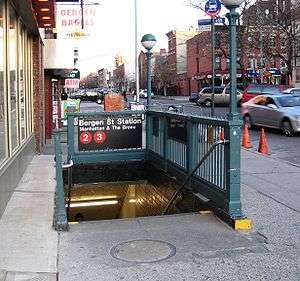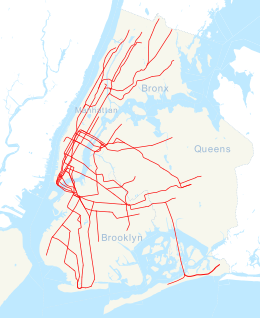Bergen Street station (IRT Eastern Parkway Line)
Bergen Street is a local station on the IRT Eastern Parkway Line of the New York City Subway, located at Bergen Street and Flatbush Avenue in Park Slope, Brooklyn. It is served by the 2 train at all times, the 3 train at all times except late nights, and the 4 train during late nights.
Bergen Street | |||||||||||
|---|---|---|---|---|---|---|---|---|---|---|---|
 | |||||||||||
| Station statistics | |||||||||||
| Address | Bergen Street & Flatbush Avenue Brooklyn, NY 11217 | ||||||||||
| Borough | Brooklyn | ||||||||||
| Locale | Park Slope | ||||||||||
| Coordinates | 40.680833°N 73.97511°W | ||||||||||
| Division | A (IRT) | ||||||||||
| Line | IRT Eastern Parkway Line | ||||||||||
| Services | 2 3 4 | ||||||||||
| Transit connections | |||||||||||
| Structure | Underground | ||||||||||
| Platforms | 2 side platforms | ||||||||||
| Tracks | 6 | ||||||||||
| Other information | |||||||||||
| Opened | October 10, 1920 | ||||||||||
| Station code | 339[1] | ||||||||||
| Wireless service | |||||||||||
| Opposite-direction transfer available | No | ||||||||||
| Traffic | |||||||||||
| Passengers (2019) | 1,208,319[3] | ||||||||||
| Rank | 330 out of 424[3] | ||||||||||
| Station succession | |||||||||||
| Next north | Atlantic Avenue–Barclays Center: 2 | ||||||||||
| Next south | Grand Army Plaza: 2 | ||||||||||
| |||||||||||
| |||||||||||
| |||||||||||
History
The Bergen Street, Grand Army Plaza, and Eastern Parkway–Brooklyn Museum stations opened on October 9, 1920.[4] Service on the IRT Eastern Parkway Line had been extended from Atlantic Avenue to Utica Avenue in August 1920,[5] but the three stations were not ready to open with the rest of the line.[4] This extension was part of an expansion of the subway system known as the Dual Contracts which built not only IRT lines in Brooklyn but also those for the BMT. The BMT Brighton Line was already in use at the time but used trackage that is now part of the Franklin Avenue Shuttle; the opening of the subway line beneath Flatbush Avenue provided a more direct route to Downtown Brooklyn and, eventually, Manhattan.[4][6]
During the 1964–1965 fiscal year, the platforms at Bergen Street, along with those at four other stations on the Eastern Parkway Line, were lengthened to 525 feet (160 m) to accommodate a ten-car train of 51-foot IRT cars.[7]
Station layout
| G | Street level | Exit/entrance |
| B1 | Side platform | |
| Northbound local | ← ← ← | |
| Curtain wall | ||
| Northbound express | ← | |
| Brighton Line | ← | |
| | ||
| Southbound express | | |
| Curtain wall | ||
| Southbound local | | |
| Side platform | ||
The station contains six tracks and two side platforms: the outermost tracks are used by the IRT local trains. To the inside are the IRT express tracks, which slant upward to the inside of the outer local tracks. In between the express tracks are the BMT Brighton Line tracks. Those routes were built at the same time as the tracks at this station as part of the Dual Contracts. A full curtain wall separates the local from the express tracks, though a gap exists in the curtain wall at the end of the station.
Both platforms have their original mosaics. The name tablets read "BERGEN ST." in gold Times New Roman font on a blue background and multi-layered green border. The trim line is green with "B" tablets on them on a blue background at regular intervals. At either ends of both platforms, where they were extended in 1964–1965,[7] there are cinderblock tiles with signs reading "BERGEN ST" in sans serif font on a maroon background.
The platforms only have columns at the fare control areas and they are i-beam columns painted green.
Exits
Each platform has one same-level fare control area at the center and there are no crossovers or crossunders. The southbound platform has an unstaffed fare control area containing a bank of three regular turnstiles, two exit-only turnstiles, and two High Entry/Exit Turnstiles. Outside fare control are two staircases going up to the southwestern corner of Flatbush Avenue and Bergen Street and a passage leading to another staircase going up to the northwestern corner.[8] The Manhattan-bound platform has a full-time turnstile bank and token booth. Outside fare control are and two staircases going up to either eastern corners of Bergen Street and Flatbush Avenue, as well as a closed and sealed stair to the southwestern corner of Sixth Avenue and Bergen Street.
References
- "Station Developers' Information". Metropolitan Transportation Authority. Retrieved June 13, 2017.
- "NYC Subway Wireless – Active Stations". Transit Wireless Wifi. Retrieved November 13, 2019.
- "Facts and Figures: Annual Subway Ridership 2014–2019". Metropolitan Transportation Authority. 2020. Retrieved May 26, 2020.
- "Subway Stations Opened: Last Three in Eastern Parkway Branch of I.R.T. Put Into Service" (PDF). New York Times. October 11, 1920. Retrieved December 20, 2015.
- "More Interborough Service for Brooklyn 2 New Lines". pudl.princeton.edu. Interborough Rapid Transit Company. August 23, 1920. Retrieved September 19, 2016.
- "IRT Brooklyn Line Opened 90 Years Ago". New York Division Bulletin. New York Division, Electric Railroaders' Association. 53 (9). September 2010. Retrieved August 31, 2016 – via Issuu.
- Annual Report 1964–1965. New York City Transit Authority. 1965.
- "MTA Neighborhood Maps: Park Slope/Prospect Park" (PDF). mta.info. Metropolitan Transportation Authority. 2015. Retrieved 2 August 2015.
External links
| Wikimedia Commons has media related to Bergen Street (IRT Eastern Parkway Line). |
- nycsubway.org
- Brooklyn IRT: Bergen Street (text used with permission)
- Brooklyn IRT: Map 2, Brooklyn IRT Dual Contracts (includes current and former track configurations, and provisions for future connections)
- Station Reporter — 2 Train
- Station Reporter — 3 Train
- The Subway Nut — Bergen Street Pictures
- Bergen Street entrance from Google Maps Street View
- Northbound platform from Google Maps Street View



%26groups%3D_c62299b71a399ab3284eb01517517959b9b66a23.svg)